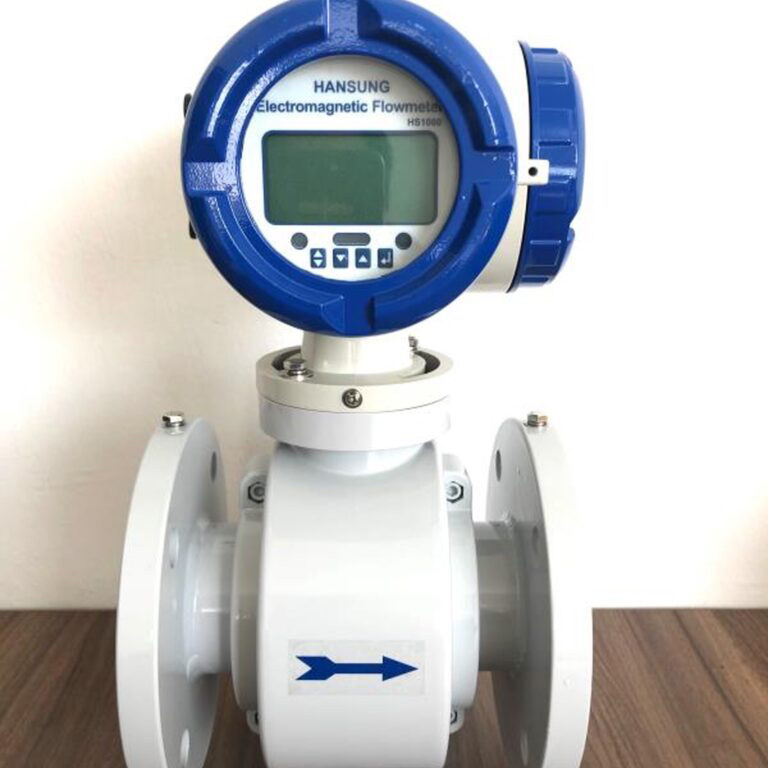
HS4000 Type
Fully welded sensor structure, stainless steel overall, for harsh use situations.
- Overview of the product
- Dimensions: DN25, DN32, DN40, DN50, DN65, DN80, DN100, DN125, DN150, DN200, DN250, DN300, DN350, DN400, DN500, DN600, DN700, DN800, DN900, DN1000
- Application: Measure wastewater, clean water, distilled water, chemical water, oil liquid …
- Materials: Cast iron body, PTFE, TEFLON seal gasket
- Voltage: 24VDC, 220V AC, 380V AC, Use battery
- Output signal: 4 ~ 20 mA, RS485, RS232 to display instantaneous flow
- Waterproof standard: IP67, IP68
- Sensor materials 316L
- Material of the meter’s inner lining: Teflon or PTFE, resistant to temperature and corrosion
- Display LCD 2 lines with 16 characters
- Signal available: Feedback / Error rate: +_ 5%
- Working temperature 0 ~ 180oC
- Brand: Woteck, Hansung
- Made in : Taiwan, Korea
- Product availability : Available
- WORKING PROCEDURES
- Electromagnetic flow meterworks based on electromagnetic inducting phenomenon. When a conductor passes through a magnetic field, an inductive electric charge will be generated inside, so when there is flow passing through the magnetic field in the sensor, the two electrodes will generate an induced electromotive force and the induced electromotive force will be proportional to the flow rate through the sensor which will measure the flow rate indicators and the flow rate through the valve. Thereby the indicators will be displayed on the LCD display
- In addition, for electromagnetic meters using turbine sensors, when water flows through and impact on the turbine, thereby turning the turbine, this number of turning will be calculated based on the sensor that counts the number of turning and converted to a flow measurement unit.
- In addition, for electromagnetic meters using turbine sensors, when water flows through and impact on the turbine, thereby turning the turbine, this number of turning will be calculated based on the sensor that counts the number of turning and converted to a flow measurement unit.
- Some notes when installing and using Electromagnetic flow meter
- Note that you should install the meter not submerged in water, to avoid water seeping into the board and causing damage or causing a fire.
- When installing the meter, pay attention to the distance, the installation position to ensure a steady flow to help the meter accurately (refer to the catalogue for installation instructions)
- The input of the power cord needs to be sealed with tape, the power cord must not be pulled above the display surface, this will cause water to enter through the power line to the board when installing meter outdoor.
- It is necessary to tighten the bolts to ensure a solid connection, to avoid leakage of fluid flow
- For the outdoor system, it is necessary to make an abat-vent for the meter to avoid the harmful effects of nature such as rain, sun, lightning …
- Connect the earth wire directly to the ground to ensure the meter is free from magnetic contamination and give accurate measurement results
- Advantages and Disadvantages of Electromagnetic flow meter
- Advantages
- Electromagnetic flow meter has the outstanding advantage that the LCD display has two lines with 16 characters, in which line 1 continuously displays the volume of fluid passed through for one hour, line 2 shows the total amount of fluid passed through i.e. How much the amount of water discharged from the pipeline system is.
- In terms of structure, the Electromagnetic flow meter is constructed of 316L stainless steel, and 321 carbon steel helps to resist corrosion caused by the environment, fluid flow from which the meter is highly durable.
- Fluctuating water flow through the current meter produces analog signal currents corresponding to a signal level of 4 – 20mA, this signal source will be transmitted to the PLC cabinet processing center from which to control the related equipment
- Diverse in operating voltage from 24VDC, 220VAC, 380VAC suitable for all current piping systems
- Withstand high temperature and high pressure environment, and can be used outdoors, submerged in water for a short time due to the IP65, IP68 waterproof standards
- Disadvantages
- Perhaps the biggest disadvantage of this Electromagnetic flow meter is its high cost compared to conventional flow meters.
- The meter has an LCD display design attached to the valve body, so the meter cannot be submerged underwater, as this will damage the meter.
.
- Advantages
Main Specifications/ Special Features:
- Structure: sensor and probe, together with LCD display
- No pressure loss due to no internal moving parts.
- Anti-corrosion, anti-wear.
- High accuracy.
- Stable performance, high anti-vibration level.
- Operates according to Faraday’s law of electromagnetic induction.
- Can be used to accurately measure the flow rate of conductive, highly corrosive and chemical fluids.
- Widely used in petroleum, chemical engineering, pharmacy, papermaking, electrical energy and environmental protection industries.
- Explosion Prevention Standard: ExdIIBT4.
- Size: DN10 to DN500
- Standard pressure: 1.0Mpa to 40mPa
- Accuracy: ± 0.5 to 1.0%
- Power supply: 85 to 250V AC (45 to 63Hz) and 16 to 36V DC
- Output current: 0 to 10 or 4 to 20mA
- Output frequency: 0 to 5,000Hz with photoelectric isolation
- Pulse output: 0.001 to 1,000m 3/cp, 0.001 to 1,000L/cp, 0.001 to 1,000USG / cp and 0.001 to 1,000 UKG/cp
- Alarm output (with photoelectric isolation)
- Upper Alarm: ALMH
- Lower alarm: ALML
- Communication: 4-20mA RS485 (Modbus)
- Operating conditions: Ambient temperature: -10 to 60 ° C
- Relative humidity: ≤85% RH
- Atmospheric pressure: 86 to 106kPa
- Applicable liquid: conductive liquid
- Liquid temperature: -25 to 65 and 140°C
-
Conductivity: 5μs/cm
Under Construction...
